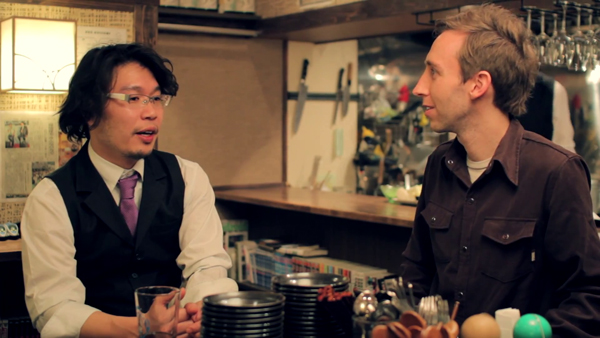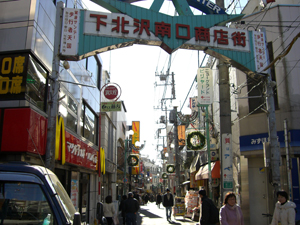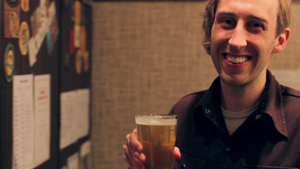Recording life in Tokyo through a lens, and sharing those images with the world, is more than just a hobby for some.
Justin Potts is on something of a mission – he, along with Nouen.tv and Gaijin Channel, wants to give the foreign community and locals alike, looking for great, unique spots in Japan, the chance to go further than Google.
When people want to know about Japan, says Potts, a Seattle native who has been living in Tokyo, collectively, he says, for “probably 6 years or so,” they “tend to assume that the best information available to them is a mere Google search away. And it’s not.”
Of his job, he says “I work with folks in regional areas around Japan, planning projects that bring the people in Tokyo (both Japanese and non-Japanese) together with proactive individuals in these different rural areas.”
The latest in this mission is Just In Japan – local discoveries. (Like the pun?) Justin takes an unpretentious, informed stroll through the backstreets of Shimokitazawa and has created something that is worth watching for long term Tokyoites as much as those fresh off the plane.
Focusing on a bar that has become something of a local institution, he chats with the owner and finds out about a part of Japanese culture that seems to be growing and growing…
The piece is smartly shot, in HD, and edited by JR Lipartio with Jim M. Ballard; even locals might learn a thing or two by ‘tuning in’. Take a look at the video, and have a read below for some insights into how and why it was made, Weekender recently chatted to Justin.
So what is the problem with search engines? Why do they sometimes not suffice in our search for something to do in Tokyo? The project says that it offers a “rare glimpse into the Japan that so many seek, but rarely find.” Why do people rarely find it and what, if anything, could they do differently?
We asked Justin a few questions and gave him a chance to spread the word about the great city of Tokyo!
Why did you start with Shimokitazawa, and where do you think you will go next?
The program will come in “two flavors”, if you will, focusing sometimes on drawing attention to and showcasing local people and culture in more rural areas of Japan, places that don’t make it into travel guides, but also areas of Tokyo where you can get a “taste” (both literally and figuratively) of the great things that come out of different regions of Japan, here in the city. A lot of folk, Japanese and non-Japanese alike, tend to miss out on them!
As for why we started with Shimokita, actually the decision to showcase Japanese craft beer with the guys at Ushitora came first, making the decision to focus on Shimokitazawa an easy one.
I happen to personally really enjoy Shimokitazawa and it always amazes me that, even given its popularity, it really isn’t on the radar of both many people as a place to go and spend time.
A lot of non-Japanese who are in Japan short-term tend to miss out on it entirely, and I’ve found that when I’ve introduced people to the area and shown them around a bit that, more often than not, it ends up becoming one of their favorite places to hang out and that they tend to continue to frequent the area and make their own discoveries.
There’s so much diversity there that you could really do an entire series on Shimokita alone (and I hope that someone does!). For a first episode, it was an area that we felt would lend itself to conveying its unique allure.
As for how we ended up targeting Ushitora, it was really kind of a perfect storm. Around the time we were solidifying the concept for this project, I was frequenting Ushitora as a customer and often introducing friends and colleagues at the same time.
When we were then discussing where we should shoot the first 2 pilot episodes (“Tokyo” and “Regional”), one of my them, half-jokingly, suggested we showcase Ushitora, as we were on a bit of a Japanese craft beer kick at the time (still am, by the way!).
We kind of chuckled at first, but then when I got together with the folks at Gaijin Channel over a beer at Ushitora to plan out our first episodes, we realized that it actually made a whole lot of sense. Japan has some amazing craft beer that a lot of visitors or casual diners will likely never discover, and almost all of it is brewed outside of the Tokyo area by folks who really care about their local area that they operate in.
Plus, it’s an easy concept for folks to grasp for a first episode. There are a lot of elements of Japan’s food culture that people still haven’t found good ways to communicate. Instead of diving into the deep end straight away, we thought it made sense to share something that people could easily relate to, and if the viewers happen to be in Tokyo, is really approachable for those who watch the video and then want to go and check it out.
We’ve already shot most of the 2nd episode in Okinawa. We just need to finish up a bit of interview footage and then it’s to the editing room!
So is this a long-term project? Where do you see it in a year/two years/five years?
I sure hope so! That’s certainly the plan, anyway.
Because we’re a small team with a lot of work we’re doing aside from this video, we likely won’t be able to do more than an episode every-other-month or so to begin with, so the first year will ideally serve as a proof of concept, demonstrating that there are a lot of interesting stories to be told that aren’t being shared, that the people involved is what really makes these stories interesting, and that people are interested in this kind of information and these kinds of stories.
Several years down the road, hopefully we’ll have ourselves a diverse collection of content that clearly conveys that, even with Japan unquestionably being on the radars of travellers, foodies and those with all sorts of special interests, that on the whole, people are really just scratching the surface of what’s out there.
Ideally this series will serve as one critical piece of a much larger puzzle that generates interest in new areas of Tokyo and Japan for both Japanese and non-Japanese, bringing people of different regions and nationalities together to help breathe life into really special parts of Japan.
A lot of media focuses on celebrities and celebrity-driven entertainment, which is fine, but that’s a world that is out of reach for the common viewer. We showcase real people who are passionate about things that are both real and accessible, which I think makes for a more interesting and personal story.
It also helps make people, places and projects that we share feel like something that a viewer can casually go to and be a part of. I think that’s a really important step in helping Japan grow and evolve in healthy ways that support local cultures, tradition, communities and people.
You say that you are “offering a rare glimpse into the Japan that so many seek, but rarely find” – why do you think people rarely find it? What could people do differently?
One reason is that, from my experience, those with the money and resources to create something and share it with a large audience tend to be very reactive in deciding where to invest time, money and energy in promoting Japan’s unique treasures, as opposed to being proactive in trying to come up with ways to shed light on new things and introduce not only new things or places, but ways of experiencing different things that Japan has to offer.
Also, to be honest, a lot of Japanese don’t find these really great things either. When you’re born and raised somewhere, everything around you is just “normal” – it’s hard to notice that you’ve got something unique and special in your backyard – everything is just “the way that it is”. And this phenomenon isn’t unique to Japan.
The best way to learn about where you’re from is to leave home. I think that’s why you’re just now starting to see more young Japanese professionals and those in mid-career returning to the “countryside”, packing up and leaving Tokyo as they realize that other parts of Japan have something to offer that Tokyo can’t.
There are some pretty fantastic things all around Japan that are entirely unique to very small local areas, but to those living there, it’s just “home”, nothing worth sharing.
There are individuals who do realize that they have something special.
A lot of them don’t have the resources or know-how to share this information, organize people and projects in effective ways, and in a sense, “produce” these places and things in ways that reach an audience capable of sustaining the resource while continuing to share it and generate interest in it.
Which leads to another point – people. Discussions centred around travel, tourism, cultural products, etc. often focus on physical things – things that you can purchase or a crafted/catered experience that you can pay for.
Now that you can buy just about whatever you want whenever you want online at the push of a button, the value placed in those things isn’t quite so significant.
However if “people” become the center of the experience, all of a sudden the reason to take interest in something and become involved becomes personal. Things that people feel like they can be a part of and/or take part in – I think that’s the next step.
And on a related but slightly different note, people tend to assume that the best information available to them is a mere Google search away – it’s not. I can’t even begin to list the number of things about Japan for which there is no good information on in English – or maybe no real information at all. This is another reason why people actually getting involved so crucial.
The web and social media is then an amazing tool, but people need to meet, become involved, and introduce people who are passionate about what they do and accessible. It’s definitely a slow, gradual process, but I think it’s really essential.












